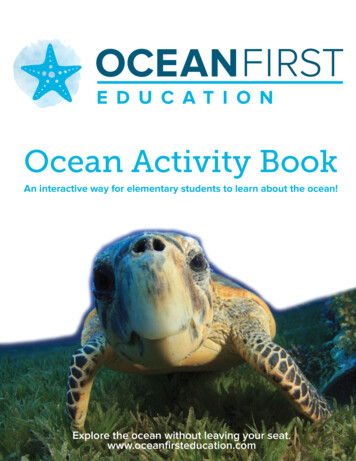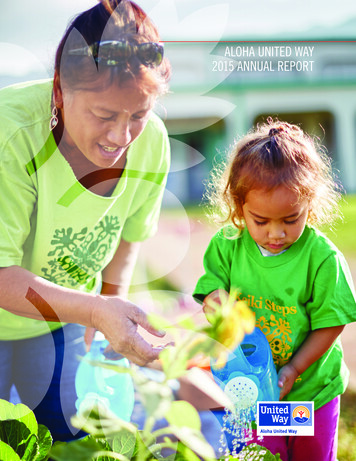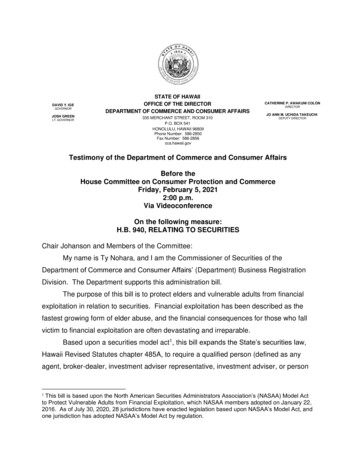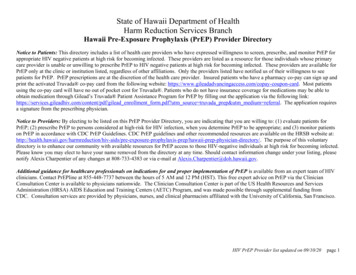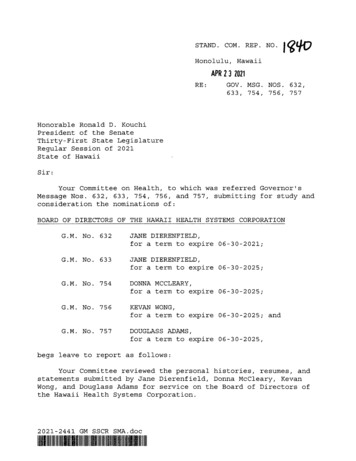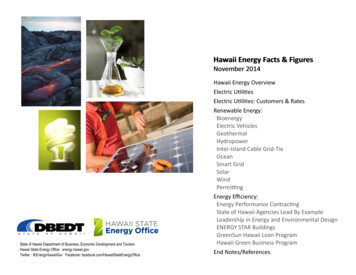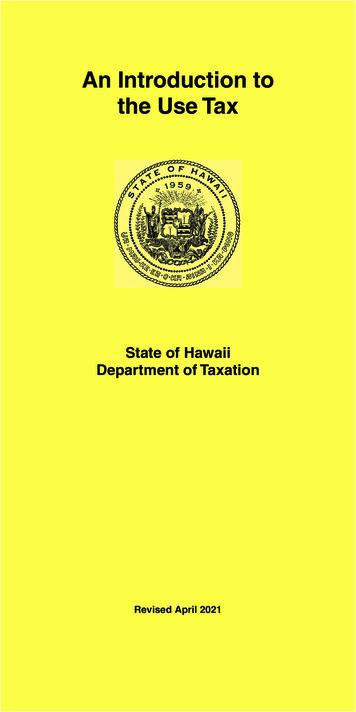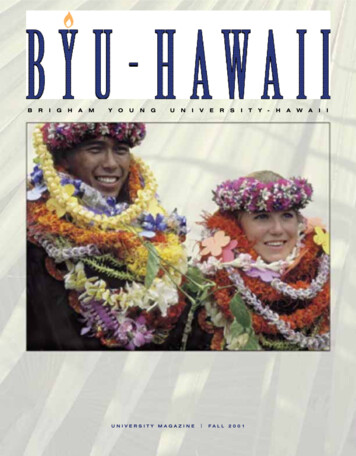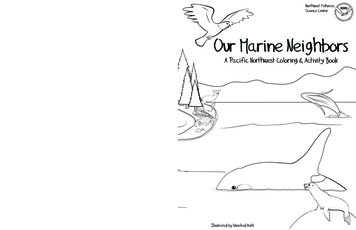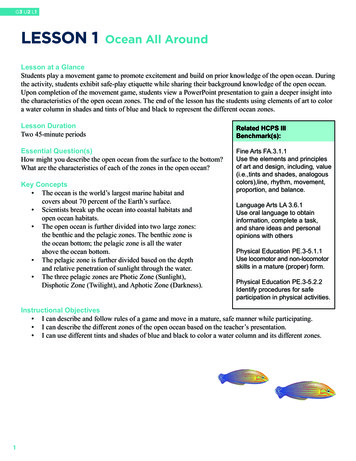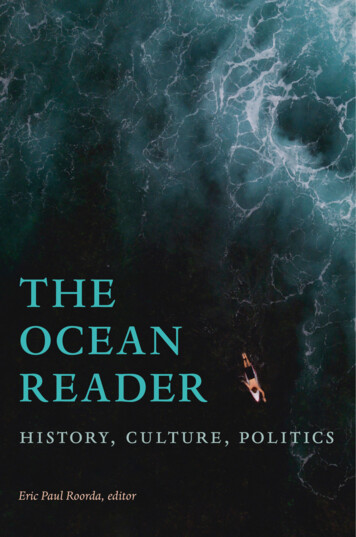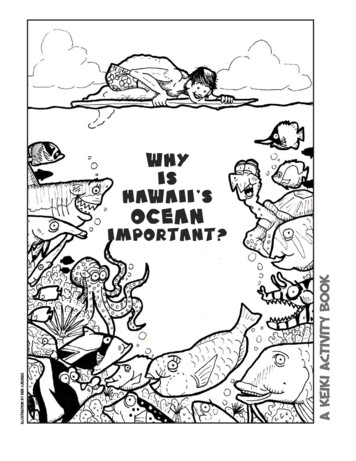
Transcription
A Keiki Activity Bookillustration by Ben LuedersWhyisHawaii’soceanimportant?
Why is Hawaii’s ocean important?Toothpaste, poke, puka shell necklaces, medicine and rain are just some ofthe things that come from the ocean.In many ways--more than we know--we are connected to the ocean. Without it,we could not survive. And guess what? the ocean depends on us too!Everything we do, including watering the grass, throwing away rubbish andsnorkeling, has a hugeeffect on the sea andthe creatures who livethere.Anything that goes downa drain in your house orneighborhood eventuallymakes its way to theocean.Grabbing or standing oncoral can kill it, not tomention threatening theanimals and plants livingthere.it’s easy to see that bytaking good care ofthe ocean, we take goodcare of ourselves.Humuhumunukunukuapuaa (Ben Lueders)Why is Hawaii’s ocean important? A keiki activity bookA publication of NOAA/National Centers for Coastal Ocean ok.pdf1
What is wrong with this reef?Can you find and color 21 things wrong with this reef?marine debris (Ben Lueders)Answers are at the bottom of this page.Answers: baseball, surfboard, hat, tire, 2 bottles, clock, bottle cap, fishing pole, snorkel mask, golf ball,anchor, barrel of toxic waste, 6-pack plastic ring, glasses, broom, soda can, football, rubber slipper,boot, hammer, nails2Why is Hawaii’s ocean important? A keiki activity bookActivity from the Hawaii Coral Reef Initiative Research k.pdf
Keep our ocean cleanHelp the lauwiliwilinukunukuoioi find its way home while keepingaway from the pollution.1Why is Hawaii’s ocean important? A keiki activity bookActivity from the Waikiki ok.pdf3
The Reef is Alive!corals are living animals, not rocks. can you find at least 12animals living among the coral and algae?Answers: wrasse (3), moorish idol, sea star, sea horse, trumpetfish, scorpionfish, anglerfish, octopus, surgeonfish, lizardfish,spiny lobster, featherduster worm, hermit crab, coral goby, shrimpfish, flounder, sea slug and more.4Why is Hawaii’s ocean important? A keiki activity bookActivity from the Waikiki ok.pdf
Secret CodeUnlock the secret messagehiding in these special codesymbols. use the chart on theright to Replace the shapesbelow with the letter equalto it. S G L A E R D F U O I V N!goatfish (Ben Lueders)Answer: A living reef gives our islands life!Why is Hawaii’s ocean important? A keiki activity bookActivity from the Hawaii’s Living Reef ook.pdf5
Make a Look Boximportant: this activity requires the help of a responsible adult.When using the box please take care not step on the coral. havefun and enjoy our beautiful ocean!1.Determine the size of the look box. For children, we favor 1 gallon buckets. Adults may wishto have a 2 - 5 gallon bucket. You can get these buckets* from paint or hardware stores.*Other options exist as well. Kitchen buckets are often too flimsy and containers with low edges tend to swamp, but plasticflower pots and other tall-sided containers make acceptable look boxes.2.Cut out the bottom of the bucket with acoping or thin bladed saw. Leave a ¼ - ½ inch lip.2-5 gal.bucket3.Lay down a bead of clear silicone caulk on theinside of the lip.cut4.Insert a piece* of clear acrylic (e.g., Plexiglas )or plastic. Press down to get a good seal. You do nothave to clean up the excess caulk that squeezes out (itwill probably just smear anyway).CaulkAdd clear plasticFinished look box5.*You can get a piece of 3/16 inch acrylic cut to your requireddimensions via any of the local plastic companies. Check the Yellow Pages for companies or you can cut your own sheet of plasticpurchased from a hardware store.Allow the caulk to dry for 24 hours.6.Check for leaks by filling the bucket. If it leaks, you can either start over or add a beadof caulk to the inner and outer edges of the acrylic. Remember to treat all marine life withrespect. If you do use the look box for holding marine life, place only one animal in the bucketat a time.* BE A GOOD REEF VISITOR and Have fun! *6Why is Hawaii’s ocean important? A keiki activity bookActivity from the Waikiki ok.pdf
Northwestern hawaiian islands word searchIslandsGeologyPlants and a mountVolcanoLimuLouluMonk GVNJWNAMark HeckmanHow many of these words can you find? Words can be backwards, forwards,diagonal and, even, backwards and diagonal.Blacktip reef shark and limu kohu (Ben Lueders)Why is Hawaii’s ocean important? A keiki activity bookActivity from the Northwestern Hawaiian Islands Coral Reef Ecosystem k.pdf7
Northwestern hawaiian islands word search answersIslandsKure atoll is the last in the chain and a true atoll.Laysan Island has one of five natural lakes in the state.Mokumanamana is the original Hawaiian name for Necker Island, one of the first twoislands in the Northwestern Hawaiian Island chain.Pearl and Hermes Reef is one of the more northern in the chain. Hawaiian pearl oysters wereharvested here until too many were taken.Plants and AnimalsLimu is the Hawaiian word for seaweed.Loulu palms are endemic to Hawaii.The Hawaiian Monk Seal is endemic to Hawaii.Sanctuary is a safe place for plants and animals to live.GeologyAtoll is a ring-shaped coral island that encloses a lagoon.Coral is an animal that creates a hard skeleton. A collection of coral can formreefs or islands.White Sand is made up of ground up coral, seashells, algae and even tiny skeletons.Sea mount is an island beneath the sea.Volcanoes created the island chain by spilling out molten ntALEZgOPXMDoWWhy is our ocean important? A keiki activity bookActivity from the Northwestern Hawaiian Isalnds Coral Reef Ecosystem k.pdfSANCTUARYAmHLLOTALAcSLNKKUREIGVNJWNA
Guess whose shark teeth!Each species of shark has a distinct shape to their teeth. Using just onetooth, scientists can identify the shark to which it belongs!Directions: Match the shark teeth on the left to the sharkthat they belong to on the right.1.A. Scalloped Hammerhead2.B. Galapagos3.C. Grey Reef4.D. TigerAnswers: 1.B, 2.A, 3.D, 4.CIllustrations by Ben LuedersWhy is Hawaii’s ocean important? A keiki activity bookActivity from the Hawaii Coral Reef Initiative Research k.pdf9
write your own comic stripBen Luedersif they could talk, what would sea creatures say to each other? Takea look at this ocean scene and write things they would say.10Why is Hawaii’s ocean important? A keiki activity bookActivity from the Hawaii Coral Reef Initiative Research k.pdf
Matching game: larvae to adultwhen many sea creatures hatch from their egg, they are called larvae. often,larve look different from the adults they will become.Can you match the adults on the left with their larval form on the right?answers are at the bottom of this page.A. Flounder1.B. Pencil Urchin2.C. ScorpionfishD. Cauliflower Coral3.4.E. Sea Snail5.Answers: A.2, B.5, C.1, D.3, E.4Illustrations by Ben LuedersWhy is Hawaii’s ocean important? A keiki activity bookActivity from the Hawaii Coral Reef Initiative Research k.pdf11
How to draw a monk sealDirections: Use a pencil, for you will have to erase a line at the end.When you arefinished, you can trace over the pencil lines in pen or color your seal.1. Draw two oval eyes.There are fewer than 1500 Hawaiianmonk seals left in the world. Babymonk seals (called pups) make a“mwaa, mwaa, mwaa” sound whencalm and a loud “aaah” or “gaah”when scared. Adults make a “bubbling” sound when alarmed.2. Draw the face, nose and mouth.3, Draw dots in and next to the eyes.Draw a chin and dots for whiskersnear the nose. Draw the body.4. Draw flippers and a tail. Erasethe bottom portion of the headleaving the chin. You are finished!Illustrations by Ben Lueders12Why is Hawaii’s ocean important? A keiki activity bookActivity from the Hawaii Coral Reef Initiative Research k.pdf
Whale IdentificationScientists identify individual humpback whales by studying their tails, which are also knownas flukes. The scalloping, color patterns and scars on the underside of the flukes are asunique as your fingerprints.Approximately 5,000 humpback whales migrate to the warm, protected waters of Hawaii eachyear, making Hawaii a great place for whale researchers to learn more about this endangered species.match the numbered flukes on the left with the flukes on the right.A1B23C4DAnswers: 1 D, 2 B, 3 A, 4 CWhy is Hawaii’s ocean important? A keiki activity bookActivity from the Hawaiian Islands Humpback Whale National Marine ook.pdf13
local namesBecause of Hawaii’s many different cultures, some sea creatures have manydifferent names. Can you match up the creatures on the left with their localnames on the right?*HInt: Some of them may have more than one name. Answers are at the bottom of this page.1. Octopus2. Dolphin3. SoldierfishA.Naia (Hawaii)B.Mano puele (Hawaii)c.hee (Hawaii)D.Tako (Japan)E.Manini (Hawaii)F.Menpachi (Japan)G.Marracho tigre (Portugal)H.Wawaeiole (Hawaii)I.Popoklo (philippines)J.Uu (Hawaii)4. Convict Tang5. Tiger Shark (juvenile)6. Codium EduleIllustrations by Ben LuedersAnswers: 1. C&D, 2. A, 3. F&J, 4. E, 5. B&G, 6. H&I14Why is Hawaii’s ocean important? A keiki activity bookActivity from Hawaii Coral Reef Initiative Research k.pdf
Color by numberColor in this adult and juvenile UHU (Parrotfish) usingthe color key as your guide.1 Cerulean (Bright blue)2 blue3 turquoise4 orange5 pink6 lime-green7 yellow8 grey9 blackParrotfish are a major source of sand. As theygraze on coral to get at algae hidden within, specialbones in their throat grind up the coral chunks.Eventually, the ground coral exits the back end ofthe fish as sand.Adult and juvenile uhu (Ben Lueders)Why is Hawaii’s ocean important? A keiki activity bookActivity from the Hawaii Coral Reef Initiative Research k.pdf15
Limu pressHow to keep your own algal specimenA long time ago, before freeze drying and refrigeration, scientific explorers needed toinvent a way to preserve samples of newly discovered plant species. This inspired thecreation of the plant press, a method that removes water from the plant.This activity uses the basic pressing techniques still used today by scientists. Instead ofselecting only one alga per sheet, you may decide to create a collage of seaweeds byarranging a few different types on one sheet. This can become a notecard, a paperweight, orcan be framed.Ben LuedersMATERIALS pan with water paper (index cards, botany paper or heavy cardstock) waxed paper (cut into pieces to fit the card/paper; need one piece per card) old newspaper (to absorb the moisture) pieces of cloth/old sheets (cut into pieces to fit over the cards/paper) pieces of corrugated cardboard heavy weights electric fan brushes (to work the specimens)Directions for pressing your algae are on the folllowing page.16Why is Hawaii’s ocean important? A keiki activity bookActivity from the University of Hawaii at Manoa Department of .pdf
Limu presscontinued1. Collect your algae. Pinch, do not pull.2. Bring them home in fresh SEAWATER.3. Spread newspaper on work area to keep it dry.4. Fill pan with clean seawater (about ½ inch deep).5. Select algae to be used.6. Place selected algae into pan of water.7. Put heavyweight paper in the water, under the selected algae.8. Float the alga into place. You can spread, trim, and arrange.9. Lift gently paper from water with the arranged algae.10. Drain carefully as much water as possible from the paper without disturbing yourarrangement.11. Place the paper with your arrangement on a folded section of newspaper.12. Place a piece of waxed paper over the arrangement.13. Place a cloth over the waxed paper.14. Place another layer of folded newspaper over the cloth.15. Place corrugated cardboard squares on top & bottomto help dry your “sandwich”.16. Repeat this process for as many algal sheets as you have.17. Set gently entire bundle into a plant press. (Plant presses use heavy weight on topto flatten plants.)18. Dry the stack with air flow to avoid mold and mildew.19. Check stack after 24 hours. Newspaper, cloth, and cardboard may need to bechanged if a lot of water has been absorbed to prevent mold and mildew forming.20. After 3-4 days, remove arrangements. Glue card onto construction paper cutabout 1/4 to 1/2 inches wider and longer than arrangement sheet. (This will frame thearrangement.)Why is Hawaii’s ocean important? A keiki activity bookActivity from the University of Hawaii at Manoa Department of .pdf17
18Why is Hawaii’s ocean important? A keiki activity bookActivity from the Hawaiian Islands Humpback Whale National Marine ook.pdf
Why is Hawaii’s ocean important? A keiki activity bookActivity from the Hawaiian Islands Humpback Whale National Marine ook.pdf19
Turtle True or FalseThree species of sea turtles are considered native to Hawaii: green (honu),hawksbill (ea), and leatherback (lai). Two other species, the loggerhead and oliveridley are sometimes observed in Hawaiian waters.Test your knowledge of sea turtles. circle true or false next to the followingsentences. Check your answers at the bottom of the page.Illustration by Ben Lueders1. Green sea turtles are 20 years old before they become adults. T / F2. Hawksbill sea turtles use their long, narrow beaks to search for food. T / F3. The Hawksbill sea turtle eat sponges that are poisonous to humans. T / F4. It is safe to eat hawksbill sea turtles. T / F5. The hawksbill sea turtle is native to Hawaii. T / F6. Sea turtles can pull their heads or flippers into their shells. T / F7. The leatherback sea turtle has a hard shell. T / F8. The leatherback sea turtle is the world’s largest turtle. It can grow up to eightfeet long and weight up to 2,000 pounds. T / FAnswers: 1. True, 2.True, 3.True, 4.False: Hawksbill Sea Turtle meat can be poisonous to humans, 5.True, 6.False, 7.False: The Leatherback Sea Turtle has a soft shell, 8.True20Why is Hawaii’s ocean important? A keiki activity bookActivity from the Hawaiian Islands Humpback Whale National Marine ook.pdf
Mobile cutoutSupplies needed:ScissorsPaper clipsHole punchPlastic drinking straws (3)finger coralDIRECTIONS:1. Color brown and green turf algae ontopart of the finger coral.2. Cut out the four sea animals.3. Make 6 paper clip chains (two 6-inchesand four 3-inches).4. Thread and center a straw at the bottom of a 6-inch chain.5. On the left side of the same straw,thread the other 6-inch chain. On the rightside thread a 3-inch chain.ornatebutterflyfishCONTINUED ON PAGE 23Illustrations by Ben LuedersWhy is Hawaii’s ocean important? A keiki activity bookActivity from the Hawaii Coral Reef Initiative Research k.pdf21
Mobile cutoutfinger coralDIRECTIONS CONTINUED FROM PAGE 22:ornatebutterflyfish226. Thread and center a second straw atthe bottom of the 6-inch chain.7. Thread and center a third straw at thebottom of the 3-inch chain.8. Attach the animals to the remaining3-inch chains and attach to the ends of thestraws.9. (Optional) Create another chain andattach the food chain explanation to yourmobile.Why is Hawaii’s ocean important? A keiki activity bookActivity from the Hawaii Coral Reef Initiative Research k.pdf
Mobile cutoutlizard fishhow does this food chainwork?A food chain shows how some animals areherbivores (eat plants) and some are carnivores (eat animals).Yellow TangA finger coral is a planktivore, a carnivorethat eats animal larvae in the plankton.The ornate butterflyfish is a corallinavore, acarnivore that eats coral.The yellow tang is an herbivore. It eats theturf algae growing on coral.The lizardfish is a piscavore. It is a carnivorethat eats both the yellow tang andornate butteflyfish.Illustrations by Ben LuedersWhy is Hawaii’s ocean important? A keiki activity bookActivity from the Hawaii Coral Reef Initiative Research k.pdf23
Mobile cutoutlizard fishhow does this food chainwork?A food chain shows how some animals areherbivores (eat plants) and some are carnivores (eat animals).A finger coral is a planktivore, a carnivorethat eats animal larvae in the plankton.The ornate butterflyfish is a corallinavore, acarnivore that eats coral.The yellow tang is an herbivore. It eats theturf algae growing on coral.Yellow TangThe lizardfish is a piscavore. It is a carnivorethat eats both the yellow tang andornate butteflyfish.24Why is Hawaii’s ocean important? A keiki activity bookActivity from the Hawaii Coral Reef Initiative Research k.pdf
Things you can do to help1. Stand only in the sandy areas. Rocky areas are covered with a thin layerof living plants and animals, including very young coral.2. Enjoy watching fish, but do not feed them. Bread, peas, corn, otherhuman foods and human-created fish foods can be harmful to fish. Thesefoods change fish behavior or choke them.3. Swim smoothly and calmly. That way you will be able to getcloser to fish, and you won’t stir up sand that can make it harder to seethem.4. Pick up trash in the water or on the beach and place it in the rubbish bin.Plastic bags are often blown into the water by the wind. Sea turtles canmistake these plastic bags for jellyfish, their natural food, and eat them andget very sick or die.5. Use waterproof sunscreen when going into the ocean. Sunscreen that isnot waterproof washes off into the water and pollutes the water.6. Use the restrooms found throughout the beach park. Going to thebathroom in the water adds unwanted nutrients.7. Do not take anything that belongs at the beach. Leave the rocks, shells,and sand there. Take only photos and memories away with you.8. Share this information with a friend. Take the time to teachothers how to take care of Hawaii’s living reefs and ocean.Why is Hawaii’s ocean important? A keiki activity bookThis activity was brought to you by the University of Hawaii Sea pdf25
Copies of this activity book can be downloaded hibook.pdffor more activity books, visit the following pages:Chesapeake Bay Activity Book: http://www.nccos.noaa.gov/education/cbbookCoastal North Carolina Activity Book: k.pdfSalish Sea Activity Book: k.pdfMobile Bay Activity Book: k.pdfProduced by: Hawaii Coral Reef Initiative Research ProgramUnder the direction of: NOAA/National Centers for Coastal Ocean SciencesIn collaboration with: Hawaiian Islands Humpback Whale National Marine Sanctuary, University of Hawaii Sea Grant, Northwestern Hawaiian Islands Coral Reef Ecosystem Reserve,University of Hawaii at Manoa Department of Botany, Waikiki Aquarium, State of HawaiiDivision of Aquatic Resources, Hawaii’s Living Reef CampaignDesigned by Lisa HuynhJuly 2005
How to draw a monk seal Directions: Use a pencil, for you will have to erase a line at the end.When you are finished, you can trace over the pencil lines in pen or color your seal. There are fewer than 1500 Hawaiian monk seals left in the world. Baby monk
